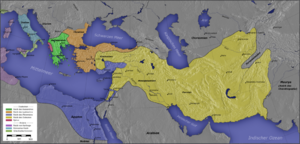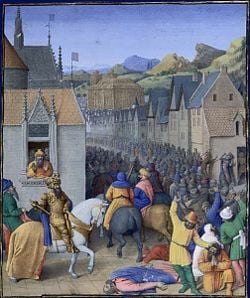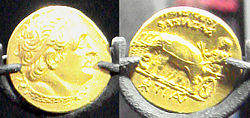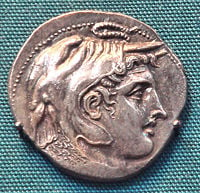Ptolemy I Soter
| Ptolemy I Soter Founder of the Ptolemaic dynasty | |
 Bust of Ptolemy I in the Louvre Museum
| |
| Born | 367 B.C.E. Macedon |
|---|---|
| Died | 283 B.C.E. (aged 84) Alexandria, Ptolemaic Kingdom |
| Spouse(s) | Artakama Thaïs Euryrdice Berenice |
| Children | Ptolemy II Philadelphus Ptolemy Keraunos Meleager Arsinoe Lysandra Ptolemais |
| Parents | Lagus and Arsinoe of Macedonia |
Ptolemy I Soter (Greek: Πτολεμαῖος Σωτήρ, Ptolemaĩos Sōtḗr, i.e., Ptolemy the Savior, (ca. 367 B.C.E. — ca. 283 B.C.E.) was a Macedoniaian general under Alexander the Great who became ruler of Egypt (323 B.C.E. — 283 B.C.E.) and founder of Ptolemaic dynasty which ruled Egypt until the Roman conquest in 30 C.E. In 305/304 B.C.E. he took the title of pharaoh. Ptolemy I was one of Alexander the Great's most trusted generals, and among the seven somatophylakes, or bodyguards, attached to his person. He was a few years older than Alexander, and his intimate friend since childhood. He may even have been in the group of noble teenagers tutored by Aristotle. He was with Alexander from his first campaigns, and played a principal part in the later campaigns in Afghanistan and India. At the Susa marriage festival in 324, Alexander had him marry the Persian princess Artakama. Ptolemy is also known to have had a consort in Thaïs.
Ptolemy I's legacy lived on in the dynasty he founded and in the tradition of cultural patronage and fusion which he initiated. The Ptolemies ruled longer than any other dynasty established by Alexander's successors. A flourishing center of learning and scholarship, Ptolemaic Egypt gave the world significant advances in the sciences and in many other areas of knowledge and its greatest library, sadly destroyed. The synthesis of Greek and Egyptian customs, beliefs and practices created by Ptolemy I and his heirs remains a subject for study and research. Against the view of some that multiculturalism is a chimera, the Ptolemaic period of Egypt's history launched by Ptolemy I and sustained by his heirs can be examined as an example of a flourishing, vibrant polity.
Lineage
He was the son of Arsinoe of Macedonia, and, while his father is unknown, he was described in ancient times as either the son of Lagus, a Macedonian nobleman, or that he was an illegitimate son of Philip II of Macedon (which would make him the half-brother of Alexander the Great if true).
Successor of Alexander
When Alexander died in 323 B.C.E., Ptolemy is said to have instigated the resettlement of the empire made at Babylon. Through the Partition of Babylon, he was now appointed satrap of Egypt, under the nominal kings Philip Arrhidaeus and the infant Alexander IV; the former satrap, the Greek Cleomenes, stayed on as his deputy. Ptolemy quickly moved, without authorization, to subjugate Cyrenaica.
By custom, kings in Macedonia asserted their right to the throne by conducting the burial of their predecessor. Probably because he wanted to pre-empt Perdiccas, the imperial regent, from staking his claim in this way, Ptolemy took great pains in acquiring the body of Alexander the Great, placing it temporarily in Memphis. Ptolemy then openly joined the coalition against Perdiccas. Perdiccas appears to have suspected Ptolemy of aiming for the throne himself, and maybe decided that Ptolemy was his most dangerous rival. Ptolemy executed Cleomenes for spying on behalf of Perdiccas — this removed the chief check on his authority, and allowed Ptolemy to obtain the huge sum that Cleomenes had accumulated.[1]
In 321, Perdiccas invaded Egypt. Ptolemy decided to defend the Nile, and Perdiccas's attempt to force it ended in fiasco, with the loss of 2000 men. This was a fatal blow to Perdiccas' reputation, and he was murdered in his tent by two of his subordinates. Ptolemy I immediately crossed the Nile, to provide supplies to what had the day before been an enemy army. Ptolemy was offered the regency in place of Perdiccas; but he declined[2]. Ptolemy was consistent in his policy of securing a power base, while never succumbing to the temptation of risking all to succeed Alexander.[3]
In the long wars that followed between the different Diadochi, Ptolemy's first goal was to hold Egypt securely, and his second was to secure control in the outlying areas: Cyrenaica and Cyprus, as well as Syria, including the province of Judea. His first occupation of Syria was in 318, and he established at the same time a protectorate over the petty kings of Cyprus. When Antigonus One-Eye, master of Asia in 315, showed dangerous ambitions, Ptolemy joined the coalition against him, and on the outbreak of war, evacuated Syria. In Cyprus, he fought the partisans of Antigonus, and re-conquered the island (313). A revolt in Cyrene was crushed the same year.

In 312, Ptolemy and Seleucus, the fugitive satrap of Babylonia, both invaded Syria, and defeated Demetrius Poliorcetes ("besieger of cities"), the son of Antigonus, in the Battle of Gaza. Again he occupied Syria, and again—after only a few months, when Demetrius had won a battle over his general, and Antigonus entered Syria in force—he evacuated it. In 311, a peace was concluded between the combatants. Soon after this, the surviving 13-year-old king, Alexander IV, was murdered in Macedonia, leaving the satrap of Egypt absolutely his own master. The peace did not last long, and in 309 Ptolemy personally commanded a fleet that detached the coastal towns of Lycia and Caria from Antigonus, then crossed into Greece, where he took possession of Corinth, Sicyon and Megara (308 B.C.E.). In 306, a great fleet under Demetrius attacked Cyprus, and Ptolemy's brother Menelaus was defeated and captured in another decisive Battle of Salamis. Ptolemy's complete loss of Cyprus followed.
The satraps Antigonus and Demetrius now each assumed the title of king; Ptolemy, as well as Cassander, Lysimachus and Seleucus I Nicator, responded by doing the same. In the winter of 306 B.C.E., Antigonus tried to follow up his victory in Cyprus by invading Egypt; but Ptolemy was strongest there, and successfully held the frontier against him. Ptolemy led no further overseas expeditions against Antigonus. However, he did send great assistance to Rhodes when it was besieged by Demetrius (305/304). Pausanius reports that the grateful Rhodians bestowed the name Soter ("savior") upon him as a result of lifting the siege. This account is generally accepted by modern scholars, although the earliest datable mention of it is from coins issued by Ptolemy II in 263 B.C.E.
When the coalition against Antigonus was renewed in 302, Ptolemy joined it, and invaded Syria a third time, while Antigonus was engaged with Lysimachus in Asia Minor. On hearing a report that Antigonus had won a decisive victory there, he once again evacuated Syria. But when the news came that Antigonus had been defeated and slain by Lysimachus and Seleucus at the Battle of Ipsus in 301, he occupied Syria a fourth time.
The other members of the coalition had assigned all Syria to Seleucus, after what they regarded as Ptolemy's desertion, and for the next hundred years, the question of the ownership of southern Syria (i.e., Judea) produced recurring warfare between the Seleucid and Ptolemaic dynasties. Henceforth, Ptolemy seems to have mingled as little as possible in the rivalries between Asia Minor and Greece; he lost what he held in Greece, but reconquered Cyprus in 295/294. Cyrene, after a series of rebellions, was finally subjugated about 300 and placed under his stepson Magas.
In 285, Ptolemy made his son by Berenice - Ptolemy II Philadelphus his co-regent. His eldest (legitimate) son, Ptolemy Keraunos, whose mother, Eurydice, the daughter of Antipater, had been repudiated, fled to the court of Lysimachus. Ptolemy I Soter died in 283 B.C.E. at the age of 84. Shrewd and cautious, he had a compact and well-ordered realm to show at the end of 40 years of war. His reputation for bonhomie and liberality attached the floating soldier-class of Macedonians and Greeks to his service, and was not insignificant; nor did he wholly neglect conciliation of the Egyptian population.
Administration
Alexandria, the port city founded by Alexander the Great, was developed as the new capital, where his palace was located. He continued to build the city following Alexander's original plan. Roman historian Tacitus says that he built the city's walls, temples and established "religious rites." He began work on the Lighthouse, which was completed under Ptolemy II. He built Alexander's Temple-tomb complex.[4] Most senior officials under Ptolemy and his successors were Greek. The traditional monarchs (hereditary provincial governors) were made subservient to a new layer of governance known as stategoi (generals) who were also Greek. While the priesthood was patronized and left in place, the revenue from the Temples, previously administered by the priests, were controlled by the king. Greek, not Egyptian, was the official language.[5] The army was mainly Greek, recruited from Macedonia and from Greece and paid for by allotments of land. The traditional Egyptian military class was retained but mainly deployed as police and internal security and were rarely used "in actual combat." Other Greek settlers were also invited to help to run the administrative system. Most were dispersed among the general population rather than living in Greek colonies. However, they often maintained a distinctive life-style and were subject to a different system of civil law. On the other hand, "intermarriage was common" so that "ultimately the distinction between Greeks and Romans came to be more a matter of language and of culture than of descent."[6] Gutzwiller says that "daily life" among the Egyptian peasants was left largely unchanged under Ptolemy I's administration.[7]
Patron of learning and religious
Ptolemy I, like Alexander, was interested in promoting scholarly inquiry and was a patron of letters, founding the Great Library of Alexandria.[8] He gathered "men of learning" around his court. McKenzie also thinks it likely that Ptolemy I started the Library. McKenzie, 41.</ref> Those known as "friends" served as his chief advisers, whether of noble or of common status.[9] He himself wrote a history of Alexander's campaigns that has not survived. This used to be considered an objective work, distinguished by its straightforward honesty and sobriety. However, Ptolemy may have exaggerated his own role, and had propagandist aims in writing his History. Although now lost, it was a principal source for the surviving account by Arrian of Nicomedia (c. 87 - after 145).
He invited the famous philosopher Strabo to Alexandria as tutor to his son. Euclid the mathematician was one of the scholars whom he patronized. Famously, when Ptolemy asked Eculid for a short-cut to understanding geometry, the sage replied "There is no royal road to geometry."[10]
Ptolemy saw himself as a "regenerator" of Egypt and deliberately set about to achieve a synthesis of Hellenic and Egyptian culture that would also lend legitimacy to his dynasty. He "reintroduced the custom of royal brother-sister marriages" and commissioned the building of temples to Egyptian deities, five of which survive.[11] Ptolemy is depicted in scenes dressed as an Egyptian pharaoh "performing the divine rituals." The best known example of cultural synthesis centered on the worship of Serapis, a hybrid between "the Egyptian God Osiris and various Greek deities." He built a Temple dedicated to Serapis in Alexandria. The cult gained popularity throughout the Greek-speaking world. He also established a cult surrounding Alexander the Great, which later developed into the "official state religion of the Ptolemaic dynasty."[11] Alexander is typically depicted as "wearing the ram's horns of Amun-Re" indicating his divinity.[12] Ptolemy and his wife were deified after their deaths. His son and successor had himself and his wife (also his sister) "proclaimed as the Theoi Adelphoi (Brother and Sister-Gods) during their own lifetime" after which "all the rulers of the Ptolemaic dynasty in turn became gods while they were still alive."[12] Ptolemy I successfully appealed to both a Greek and an Egyptian audience.[13]
Legacy
Ptolemy I's legacy lived on in the dynasty he founded and in the tradition of cultural patronage and cultural fusion which he initiated. A flourishing center of learning and scholarship, Ptolemaic Egypt gave the world the Greek translation of the Hebrew Bible, important developments in mathematics and medicine and its greatest library, sadly destroyed. We continue to be indebted to the Ptolemies for much of what we know about Ancient Egypt, since accounts written under their patronage recorded the history of Egypt and include the lists of 30 dynasties. The synthesis of Greek and Egyptian customs, beliefs and practices created by Ptolemy I and his heirs remains a subject for study and research. This society did not implode or collapse due to any type of internal weakness, although it never really enjoyed widespread popularity among the Egyptian population but fell to a superior military power. This cultural synthesis inspired the work of the Jewish philosopher, Philo of Alexandria and produced the cultural context in which Gnosticism later flourished. Against the view of some that multiculturalism is a chimera, the Ptolemaic period of Egypt's history can be examined as an example of a flourishing, vibrant polity.
Fictional portrayals
- Ptolemy was played by Vergilio Teixeira in the film Alexander the Great (1956) and by Robert Earley, Elliot Cowan, and Anthony Hopkins in the Oliver Stone film Alexander (2004).[14]
- L. Sprague de Camp's novel The Bronze God of Rhodes features Ptolemy as a minor character.[15] He also appears in Harry Turtledove's novel The Gryphon's Skull.[16]
- Duncan Sprott's novel The Ptolemies features Ptolemy as a central character and founder of the Ptolemaic Dynasty.
- Jonathan Stroud's The Bartimaeus Trilogy.
- Ptolemy appears as a character in Mary Renault's novels Fire From Heaven, The Persian Boy, and Funeral Games. He also appears in her non-fiction work The Nature of Alexander.
- Ptolemy is one of the minor characters in the historical novel Roxana Romance by A. J. Cave with the Hellenic spelling of Ptolemaios.
| Ptolemaic dynasty Born: 367 B.C.E.; Died: 283 B.C.E. | ||
|---|---|---|
| Preceded by: Alexander IV Aegus |
Pharaoh of Egypt 305–283 B.C.E. |
Succeeded by: Ptolemy II Philadelphus |
Notes
- ↑ Peter Green. Alexander to Actium: the historical evolution of the Hellenistic age. (Berkeley, CA: University of California Press, 1990. ISBN 9780520056114), 13-14.
- ↑ Green, 14.
- ↑ Green, 119.
- ↑ Judith McKenzie. The architecture of Alexandria and Egypt, c. 300 B.C.E. to A.D. 700. (New Haven, CT: Yale University Press, 2007. ISBN 9780300115550), 41.
- ↑ John D. Fage. The Cambridge history of Africa, Vol. 1 From the earliest times to c. 500 B.C.E. (Cambridge, UK: Cambridge Univ. Press, 1982. ISBN 9780521222150), 151.
- ↑ Fage, 152.
- ↑ Kathryn J. Gutzwiller. A guide to Hellenistic literature. (Malden, MA: Blackwell Pub., 2007. ISBN 9780631233213), 17.
- ↑ Some argue that the Library was built by Ptolemy II but Collins cites evidence that it was begun by Ptolemy I, who certainly provided a place for his scholars to work. See Nina L. Collins. The library in Alexandria and the Bible in Greek. (Supplements to Vetus Testamentum, v. 82.) (Leiden, NL: Brill, 2000. ISBN 9789004118669), 111.
- ↑ Collins, 94.
- ↑ Matthew Battles. Library: an unquiet history. (New York, NY: W.W. Norton, 2004. ISBN 9780393020298), 59.
- ↑ 11.0 11.1 A. Rosalie David. Handbook to life in ancient Egypt. (Oxford, UK: Oxford University Press, 1999. ISBN 9780195132151), 43.
- ↑ 12.0 12.1 Fage, 150.
- ↑ Gutzwiller, 17.
- ↑ Alexander the great (1956). Internet Movie Data Base. Director and writer: Robert Rossenn. Retrieved February 21, 2009.
- ↑ L. Sprague De Camp. The bronze god of Rhodes. (New York, NY: Bantam Books, 1963.)
- ↑ H.N. Turteltaub. The gryphon's skull. (New York, NY: Forge, 2002. ISBN 9780312872229).
ReferencesISBN links support NWE through referral fees
- Battles, Matthew. 2004. Library: an unquiet history. New York, NY: W.W. Norton. ISBN 9780393020298.
- Bingen, Jean, and Roger S. Bagnall. 2007. Hellenistic Egypt: monarchy, society, economy, culture. Hellenistic culture and society, 49. Berkeley, CA: University of California Press. ISBN 9780520251410.
- Cave, A.J. 2008. Roxanâ romance = Rošanak Nâmeh. San Mateo, CA: Pavastâ. ISBN 9780980206104.
- Collins, Nina L. 2000. The library in Alexandria and the Bible in Greek. (Supplements to Vetus Testamentum, v. 82.) Leiden, NL: Brill. ISBN 9789004118669.
- David, A. Rosalie. 1999. Handbook to life in ancient Egypt. Oxford, UK: Oxford University Press. ISBN 9780195132151.
- De Camp, L. Sprague. 1963. The bronze god of Rhodes. New York, NY: Bantam Books. Fiction.
- Ellis, Walter M. 1994. Ptolemy of Egypt. London, UK: Routledge. ISBN 9780415100205.
- Fage, John D. 1982. The Cambridge history of Africa 1 From the earliest times to c. 500 B.C.E. Cambridge, UK: Cambridge Univ. Press. ISBN 9780521222150.
- Gutzwiller, Kathryn J. 2007. A guide to Hellenistic literature. (Blackwell guides to classical literature.) Malden, MA: Blackwell Pub. ISBN 9780631233213.
- Green, Peter. 1990. Alexander to Actium: the historical evolution of the Hellenistic age. (Hellenistic culture and society, 1.) Berkeley, CA: University of California Press. ISBN 9780520056114.
- Kincaid, C.A. 1969. Successors of Alexander the Great. Chicago, IL: Argonaut. ISBN 9780890053522.
- McKenzie, Judith. 2007. The architecture of Alexandria and Egypt, c. 300 B.C.E. to A.D. 700. (Yale University Press Pelican history of art.) New Haven, CT: Yale University Press. ISBN 9780300115550.
- Renault, Mary. 1972. The Persian boy. New York, NY: Pantheon Books. ISBN 9780394481913. Fiction.
- __________. 1975. The nature of Alexander. New York, NY: Pantheon Books. ISBN 9780394491134.
- __________. 1981. Funeral games. New York, NY: Pantheon Books. ISBN 9780394520681. Fiction.
- __________. 2002. Fire from Heaven. New York, NY: Vintage. ISBN 978-0375726828. Fiction.
- Sprott, Duncan. 2004. The Ptolemies. New York, NY: Alfred A. Knopf. ISBN 9781400041541. Fiction.
- Stanwick, Paul Edmund. 2002. Portraits of the Ptolemies: Greek kings as Egyptian pharaohs. Austin, TX: University of Texas Press. ISBN 9780292777729.
- Stroud, Jonathan. 2006. The Bartimaeus trilogy. New York, NY: Miramax Books/Hyperion. ISBN 9781423104209. Fiction.
- Turteltaub, H.N. 2002. The gryphon's skull. New York, NY: Forge. ISBN 9780312872229. Fiction.
This article incorporates text from the Encyclopædia Britannica Eleventh Edition, a publication now in the public domain.
External links
All links retrieved December 2, 2022.
- Ptolemy Soter I at LacusCurtius — (Chapter II of E. R Bevan's House of Ptolemy, 1923).
- Ptolemy I Soter entry in historical sourcebook by Mahlon H. Smith.
Credits
New World Encyclopedia writers and editors rewrote and completed the Wikipedia article in accordance with New World Encyclopedia standards. This article abides by terms of the Creative Commons CC-by-sa 3.0 License (CC-by-sa), which may be used and disseminated with proper attribution. Credit is due under the terms of this license that can reference both the New World Encyclopedia contributors and the selfless volunteer contributors of the Wikimedia Foundation. To cite this article click here for a list of acceptable citing formats.The history of earlier contributions by wikipedians is accessible to researchers here:
The history of this article since it was imported to New World Encyclopedia:
Note: Some restrictions may apply to use of individual images which are separately licensed.


